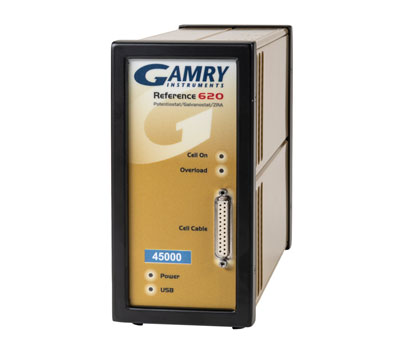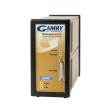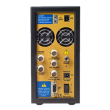Overview
The Reference 620 is a high-performance, research-grade potentiostat/galvanostat/ZRA designed for fast, low-current measurements. It does well for a variety of applications such as physical electrochemistry (especially at microelectrodes), fast cyclic voltammetry, electrochemical corrosion, electrochemical noise measurements, paints and coatings, and sensors.
It has a number of auxiliary input and outputs designed to help you interface or control ancillary equipment such as a rotating disc electrode. It also has a thermocouple input for temperature measurements.
Electrochemical Impedance Spectroscopy
The Reference 620 comes fully equipped to perform electrochemical impedance spectroscopy. The Accuracy Contour Plot shown below provides a detailed look at the performance you can expect from your instrument in real-world situations. The results include the cell cable.

Options
- Extended Cable Lengths
- Extended length cell cables (1.5 m, 3 m, 10 m) are also available for your convenience.
Below are additional details regarding the capabilities of the Reference 620 potentiostat. Each bullet point contains a list of the type of techniques available for the instrument to run.
- Physical Electrochemistry - Techniques such as cyclic voltammetry, chronoamperometry, and chronopotentiometry and derivatives of these techniques.
- Pulse Voltammetry - Techniques such as pulse voltammetry, square wave voltammetry, and associated stripping techniques such as anodic stripping voltammetry.
- DC Corrosion - Run standard DC corrosion tests such as polarization resistance, potentiodynamic, cyclic polarization, and galvanic corrosion in addition to a number of others.
- Electrochemical Energy - Test single-cells and stacks of various batteries, fuel cells or supercapacitors. Includes charge, discharge, cyclic charge-discharge techniques, potentiostatic, galvanostatic, self-discharge, leakage rate, and read cell voltage.
- Electrochemical Signal Analyzer - Designed specifically for the acquisition and analysis of time-dependent electrochemical noise signals. Cell voltage and current are continuously monitored at rates from 0.1 Hz to 1 kHz. A full featured set of analysis tools provides powerful analysis features such as statistical analysis, detrending, impedance spectra, and histogram analysis.
- Electrochemical Frequency Modulation - A non-destructive corrosion rate measurement technique. It allows for measurement of the corrosion rate without prior knowledge of the Tafel constants. In addition, the technique determines the Tafel constants and provides 2 internal validity checks.
- Critical Pitting Temperature - controls a Gamry Potentiostat, TDC5 Temperature Controller, and associated accessories to automatically measure the Critical Pitting Temperature of a material.
- Electrochemical Noise - A more general form of electrochemical noise testing. It is also an ECM8 Multiplexer compatible electrochemical noise software package.
- Electrochemical Impedance Spectroscopy - includes experimental scripts for potentiostatic, galvanostatic and hybrid impedance spectroscopy experiments in addition to single frequency techniques like Mott-Schottky. We also have our unique power-leveling multisine technique that improves signal-to-noise across the spectrum. On the analysis side, it provides tools for fitting spectra to equivalent circuit models, Kramers-Kronig transform for data validation and a graphical model editor. Our software even includes a script for EIS simulation.
- eChemDC Toolkit - contains all of the capabilities of the eChemBasic and further extends these capabilities by adding advanced signals and data acquisition modes to simplify implementing experiments like cyclic voltammetry, pulse voltammetry, and dynamic DC corrosion techniques. Also includes more advanced stop tests, particularly useful in fast experiments.
- eChemAC - Includes full capabilities of eChemDC Toolkit plus allows electrochemical impedance spectroscopy (EIS) and EFM experiments.
Other features
- 2, 3, and 4 electrode measurements
- Electrical Isolation
- Floating instrument: use with autoclaves, mechanical stress apparatus, or pipeline probes.
- Built-In EIS
- On-board DDS to perform EIS from 10 µHz to 5 MHz.
- DSP (Digital Signal Processing) Mode
- Oversamples for improved signal-to-noise and accurate capacitance measurements.
- Current Interrupt and Positive Feedback iR Compensation
- Gamry potentiostats and their controlling software use control loop algorithms to accurately measure and correct for uncompensated resistance.
- Auxiliary I/O
- Control additional equipment via additional I/O interfaces: external signal input, analog voltage output, analog current output, auxiliary A/D input, and digital I/O connector.
- Warranty
- Protected by 2-year factory service warranty.
Robust equipment with multiple applications in electrochemistry.
Rating: 4.0 
Organization: CONICET
Application Area: Applied electrochemistry and corrosion
Great result
Rating: 5.0 
Organization: Peking University
Application Area: MEMS application
Amazing instrument to use.
Rating: 5.0 
Organization: IIT Madras
Application Area: Corrosion testing of metallic samples
Great results, reproducible results, easy to use
Rating: 4.7 
Organization: UIS
Application Area: Coatings
Great results
Rating: 5.0 
Organization: Universidade Federal de Minas Gerais
Application Area: Corrosion studies
The Reference 620 Potentiostat is the Cadillac of potentiostats!
Rating: 4.0 
Organization: Pennsylvania State University
Application Area: Corrosion protection performance of organic coatings
Great results, easy to use and install
Rating: 5.0 
Organization: Federal University of Minas Gerais
Application Area: Corrosion studies
Reliable results in electrochemistry with this potentiostat.
Rating: 4.7 
Organization: Rio de Janeiro State University
Application Area: Corrosion test
Essential for the development of protective coatings.
Rating: 5.0 
Organization: Luna Innovations
Application Area: Performance of sol-gel coatings to prevent galvanic and crevice corrosion
Very good potentiostat/galvanostat, easy to use and robust.
Rating: 4.3 
Organization: The University of Akron
Application Area: Corrosion
Excellent precision and ease of use.
Rating: 4.7 
Organization: Vanderbilt University
Application Area: Electrochemistry
Excellent analytical equipment for evaluating coatings and corrosion protection.
Rating: 5.0 
Organization: Bureau of Reclamation
Application Area: Corrosion/coatings
Great results. Highly recommended.
Rating: 5.0 
Organization: IIT Madras
Application Area: Corrosion test for metallic samples
User friendly, compact and works great!
Rating: 5.0 
Organization: Arizona State University
Application Area: Corrosion studies in aerospace alloys
Easy setup, good help videos and works great!
Rating: 5.0 
Organization: ArcelorMittal Global R&D
Application Area: Corrosion testing of steels and coatings
Very good results at all times and reliable.
Rating: 5.0 
Organization: Universidad nacional Autonoma de Mexico
Application Area: Corrosion resistance
Excellent product.
Rating: 5.0 
Organization: Universidad Nacional de Colombia
Application Area: Materials characterization
Sensitive, confident and relatively easy to use instrument.
Rating: 4.7 
Organization: University of Chemistry and Technology
Application Area: Electrochemical corrosion testing
Excellent! Its a powerful instrument.
Rating: 5.0 
Organization: Chemical Engeneering Faculty and Textile
Application Area: Corrosion: natural inhibitors, corrosion rate metals, etc
Reference 600+ is the best partner in my research. Thank you for developing it.
Rating: 4.3 
Application Area: Corrosion life prediction
Makes us to belive in our results.
Rating: 4.7 
Organization: Ege University
Application Area: Analyze impedance
Very good equipment.
Rating: 4.3 
Organization: UERJ
Application Area: Corrosion, materials science
Very suitable tool for materials evaluation.
Rating: 4.7 
Organization: BAM
Application Area: Electrochemistry
Number one for sure.
Rating: 5.0 
Organization: DOW CHEMICAL
Application Area: Corrosion studies
Great results. We use the instrument daily.
Rating: 5.0 
Organization: Toyota Motor North America R&D
Application Area: Electrochemical study
High quality potentiostat.
Rating: 4.7 
Organization: University of Southern California
Application Area: Microbiology
Good, capable and portable potentiostat.
Rating: 4.7 
Organization: IMRE, A*STAR
Application Area: Electrochemical measurements, batteries, electrocatalysis
Good product.
Rating: 4.0 
Organization: EPRI
Application Area: Corrosion of metals
Great tool to measure Rp trending for corrosion measurements!
Rating: 5.0 
Organization: ExxonMobil
Application Area: Corrosion testing
Great value and functionality
Rating: 5.0 
Organization: University of Utah
Application Area: Electrochemistry of molten salts
Very reliable and versatile
Rating: 5.0 
Organization: Materia Inc
Application Area: Evaluating anti-corrosion coatings
Excellent instrument and company
Rating: 5.0 
Organization: Pulse Biosciences Inc
Application Area: Characterize dynamic tissue changes
I am satisfied by its power but software should be improved.
Rating: 4.3 
Organization: Korea Institute of Materials Science
Application Area: Corrosion tests
Excellent impedance!
Rating: 4.7 
Organization: Universidad Carlos III de Madrid
Application Area: Electrochemical corrosion in concrete, organic coatings
I already have three of them, since it is an excellent piece of equipment.
Rating: 5.0 
Organization: Universidad nacional Autonoma de Mexico
Application Area: Corrosion evaluation of coatings
Great product for lab use.
Rating: 4.3 
Organization: PowerTech Water
Application Area: Analyze carbon electrodes
Good instrument.
Rating: 4.7 
Organization: Fda
Application Area: Electrical sStimulation of bacterial biofilms
Gamry potentiostats are great. I started with one and now own six.
Rating: 5.0 
Organization: University of Canterbury
Application Area: Electrocatalysis and flow battery analysis
Excellent quality & service.
Rating: 5.0 
Organization: PPG-Whitford
Application Area: Coatings analysis
Excellent equipment!
Rating: 4.3 
Organization: Aalto University
Application Area: Supercapacitor, batteries
Great reliable results
Rating: 4.3 
Organization: Utdallas
Application Area: Electrochemical measurement
EIS is one of the important methods for coating performance evaluation
Rating: 4.7 
Organization: A Plus Coating Solutions Inc.
Application Area: Testing coating impedance
Great equipment
Rating: 4.3 
Organization: Shawcor
Application Area: Analyzing coating impedance
Reference 600+. Definitely worth the investment in terms of cost.
Rating: 5.0 
Organization: Binghamton University
Application Area: CURE. CV, CA, and EIS
Great equipment.
Rating: 5.0 
Organization: Rio de Janeiro State University
Application Area: Corrosion
Good results
Rating: 5.0 
Organization: UA
Application Area: Electrochemistry, semiconductors, sensors, impedance
Superb potentiostat
Rating: 5.0 
Organization: Acibadem University
Application Area: Electropolymerization, biosensor fabrication
Good results! Easy to use!
Rating: 5.0 
Organization: Arcelormittal
Application Area: Corrosion
Great equipment for a corrosion laboratory.
Rating: 4.3 
Organization: UERJ
Application Area: Corrosion, materials science
Great equipment - easy to use and calibrate.
Rating: 5.0 
Organization: University at Buffalo
Application Area: Corrosion measurements in reinforced concrete structures
Designed to measure impedance
Rating: 4.3 
Organization: Pamukkale University
Application Area: Impedance for conducting polymers
Great results, easy to use and install
Rating: 5.0 
Organization: Federal University of Minas Gerais
Application Area: Corrosion studies






